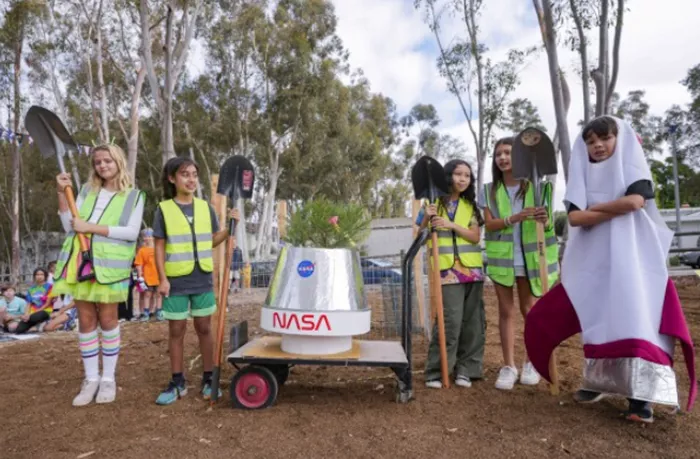LAKE FOREST, Calif. — In a vibrant ceremony filled with excitement, students wearing spacesuits and star-studded T-shirts welcomed a remarkable new addition to their school: a “Moon Tree.” This special tree was planted at Santiago STEAM Magnet Elementary School, having grown from seeds that traveled around the moon.
Accompanied by several students with shovels, the tree was brought to its new location in a wagon. Santiago STEAM Magnet, which serves around 500 students from grades K-12, was chosen to receive a giant sequoia seedling from NASA’s Artemis I Mission, which took place in 2022.
“It’s kind of crazy,” said sixth grader Emily Aguesse, who participated in the planting ceremony. “I’ve always wanted to go to space, but this motivates it even more.”
This event marks the second time NASA has sent seeds into space for planting. During the Apollo 14 mission in 1971, astronaut Stuart Roosa, a former U.S. Forest Service smokejumper, carried seeds that grew into the first generation of Moon Trees. These trees were later planted across the United States, from Alabama to Washington.
While many seedlings from that mission were given to national monuments, the latest batch is being distributed to schools and museums. This effort aims to promote science and conservation education, bringing a piece of space exploration down to Earth, according to Paul Propster, chief story architect for NASA’s Jet Propulsion Laboratory.
“It’s just kind of cool and fun to connect the next generation of explorers,” Propster said.
Scientists continue to study the effects of space travel on plant growth, and it remains unclear if there are any significant impacts. In 2022, NASA, in partnership with the Forest Service, sent nearly 2,000 seeds from five tree species aboard the unmanned Orion spacecraft. The spacecraft orbited the moon and spent approximately four weeks in space.
After returning to Earth, the seeds were cultivated into young trees, including sycamores, sweetgums, Douglas firs, loblolly pines, and giant sequoias, which can be shared with the public through an application process. Earlier this year, nearly 150 seedlings were distributed, with another batch expected this fall, according to NASA officials.
Santiago, a school focused on science and technology, planted its Moon Tree in a space-themed garden adorned with colorful stones painted by students. The school’s parent-teacher association has organized community volunteers to care for the Moon Tree, which is anticipated to thrive in the eucalyptus grove that provides shade for the Southern California campus.
Colorful ropes were arranged in circles on the ground, illustrating the potential size of the tree in 50 years and beyond.
“This tree will grow with the kids,” said Liz Gibson, chair of the NASA Moon Tree ceremony and a parent of three children at the school.
Related topics:
- Garden Plants to Prune Now for Better Flowers and Growth After Winter
- Southern California School Grows ‘Moon Tree’ from Seeds Sent to Space
- How Hemp Plants Can Help Remove ‘Forever Chemicals’ from the Environment


